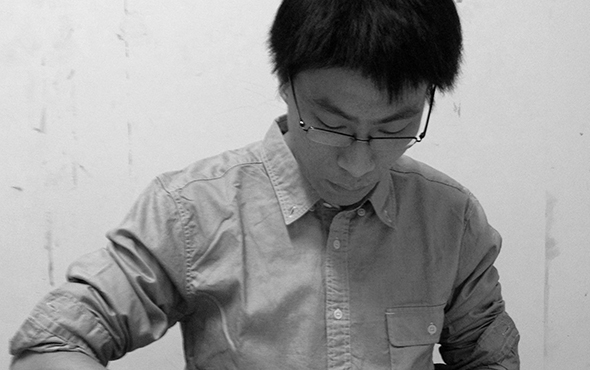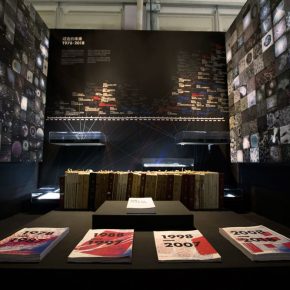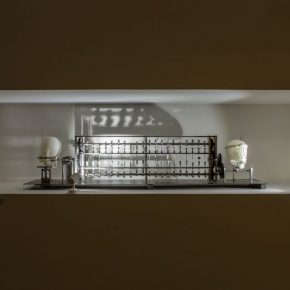
Zhang Wenchao graduated from the School of Design of the Central Academy of Fine Arts in 2008 and then continued his study for a master’s degree in the School of Fine Arts. He returned to the School of Design two years ago as a teacher. At this year’s graduation season, when he recollected the discipline of design and his creations from ten years ago, he was struck by a distant sense of time and space. At the same time, in the process of teaching and observing students’ graduation projects, he found that ten years later this discipline has undergone and is now experiencing numerous transformations. The once familiar discipline has faded away…
Interviewee: Zhang Wenchao (graduated from the CAFA School of Design in 2008)
Interview Time: June 3rd, 2018
Location: Central Academy of Fine Arts
Editor: Zhang Wenzhi
Translated by Paris Yang
CAFA ART INFO: Hello, Zhang Wenchao. We are here today to discuss the kind of situation you faced during your graduation season, the topics that you were interested in, and also the languages that you were inclined to use. In the meantime, we would like to know the current state of the graduating students and their projects in this graduation atmosphere.Zhang Wenchao: Since the beginning of the graduation season, I have processed these projects several times, and my deepest feeling is that the rhythm of the School of Design nowadays is changing rapidly because our society is now developing at an accelerated pace. Such advancement is noticeable with both technical or internal modifications or organizational relations, and also includes changes in disciplines. This reminds me of the relatively clear disciplinary boundaries in the past. Maybe graphic design would end up being presented in the form of a book, whereas digital displays were mainly about films. It was not until my graduation that smart devices came into being and interactive media began to grow.
My graduation piece She Jiang (Crossing the River) employed the path-following and topography construction functions of Google Earth (virtual earth) and combined them with my own journey. From Yichang to Chongqing, I recorded each coordinate and location that I had once sojourned, generating trajectory data and thereby tracing culture from a geographic perspective. It is easy to implement this today, but at that time the mobile Internet was not yet mature. The contour topography of Google Earth was a bit similar to the present-day 3D virtual reality, but very few people used it. Finally, my work is made up of a mix of real geography, including the subjective shooting during my journey, and the virtual environment. Along my walking route, these two trajectories were placed together to synthesize an experimental image. As you can see, I sought to break with the traditional image construction method back in the day when I was preparing for my graduation project.
CAFA ART INFO: It might be a refreshing piece of work ten years ago. So, are today’s image creations that are presented a huge difference? Students in every graduation season also use the same method in their project.Zhang Wenchao: Maybe nowadays, using this method to make a video cannot be counted as an experimental image. If I am going to remake this piece, I will conduct it via the combination of search engine algorithm and VR (virtual reality) and completely give up on the digital image for this kind of method. What was experienced here is not merely acceleration but also scores of technological advancement. For instance, interactive design in the early years was simply about making a webpage. Nevertheless, Apps are now popular. After the emergence of the Internet, students are using sensors to control entities, which squares with the general trend of the Internet of Things. This is the era of intelligence, our lives are akin to an ecological chain, and what students are making are more like every single mutually intellectualized link. However, from the time I graduated from the Academy till the present day, the logic and creation method of my work are still deeply embedded in new works. Hence, unlike media languages, which always change with the times, personal artistic thinking as well as logic will upgrade along with one’s growth. And it is them the ultimate index for us to critic the excellence of each piece of work.
Taking He Yanchao’s work Future in the Past as an example, it sorted, analyzed, judged, refined, compiled, as well as regrouped the magazines Scientific American and Science, giving rise to a literature exposition and thereby looking for inspirations from past thoughts and cognitions about the future for the present era. He primarily focused on biology, astronomy, and artificial intelligence, and was able to see the changes in the amount of attention that was paid into these topics as well as in other topics themselves over the past four decades. Notably, these topics are still hot today. Although it is a design work, it does not lose scientific property. In other words, this piece possesses certain degree in documentation value that are essential for scientific research. As for the design’s visual presentation, this work organized different levels of contents that were drawn from the general catalog of a copy of the journal article, the interior and exterior of the fly pages in a series of fly page books, and several inserts, which carry information of various sections of the literature exposition. Undoubtedly, it is the epitome of the whole literature exposition, that is, the documentation of literature.
CAFA ART INFO: After hearing what you have just said, I feel like the School of Design is pretty sensitive to the cutting-edge information of the era and is capable of presenting this kind of concern in its own creations. So, does this have a new impact on teaching?Zhang Wenchao: I was aware of this kind of sensitivity as soon as I went back to the School of Design. Adjustment and sensitivity of this sort also pose challenges to the understanding of traditional disciplines. Many artworks we see today, such as service design, which is a set of method derived from systematic works, and printed materials and books or videos, which are most likely just a form of presentation, are hard to define using the concept of graphic design or film. Some of our new courses, such as arts and technology, cross-disciplinary creative design, etc., in essence, integrate our artistic creations with the ever-changing present technologies or working methods and also embodies the sensitivity of design.
At the same time, this sensitivity also encourages students to attach more importance to the social role of their deeds, the kind of person that they will inspire, as well as the values that they will achieve.
For example, Yuan Qianxin addressed the urbanization-induced education problem of the migrant children. Taking middle-school students from the urban migrant schools as a starting point, she proposed a transitional education strategy to redesign the curriculum experience, to stimulate students’ interest in learning, awaken their wills in actively designing their own paths, and thereby to reconstruct their own concepts in the learning and practical process. In the end, it will evolve into a whole set of curriculum methodology and galvanize innocuous interactions among children, teachers, parents and society.
Centered around the concept of “A falling stone is a solemn farewell.”, Zeng Zhixuan’s Meteorites fabricated a piece of meteorite history from the beginning of the eighteenth century. He presupposed the specific cutting standard and rating method of meteorites, and arranged jewelry forms, icons and techniques, such as gold-carving, metal painting, enamel, etc., that prevailed in different historical periods. With close investigation of the morphology of jewelry, he was able to restore them to their original appearances. Then, he simulated the image of meteorites that were manifested in various media from different periods of time, such as oil painting, newspapers, posters, etc. This fictive history was, in fact, the artist’s reflection on the value of a diamond as well as symbolism. Given that diamonds stand for love and affection, meteorites, in a similar fashion, can also represent separation.
CAFA ART INFO: I think this results in a higher demand for design. Perhaps the past pursuit of visual presentation and attraction is only the foundation and final destination of the systematic work. However, the dialogues among varied disciplines that happened in the course of completing works require artists to maneuver knowledge from diverse fields of study.Zhang Wenchao: This view is not confined solely to the discipline of design. Many creative fields nowadays are now breaking boundaries. Owing to the status quo, students ought to equip themselves with the ability to organize their works by skillfully handling resources from different disciplines and knowledge systems. They should no longer be restricted by language patterns in a single system but need to employ the logic of thinking from different fields of study and use varied means to assist research and solve problems. I empathized this point in the process of my own artistic creations, which is quite helpful in my teaching. This assistance is evident in guiding students how to mobilize different resources and eventually establish a set of unique working methods. Completely abandoning barriers in teaching, of course, is a big challenge for teachers. Facing students with different knowledge backgrounds, teachers should realize that it is also a process of self-improvement. Just like I mentioned earlier, it is pivotal to always keep sensitive and force ourselves to update our knowledge system.
Li Jingyang’s The Three Hypotheses of Evolutionism is an interactive image driven by three groups of transmission devices. These three hypotheses all stemmed from noted mysteries and conspiracy theories. The work was divided into three parts: birth, development, and extermination. The hypotheses were executed in the form of successive images circulating around these three parts. The occurrence of animation would change accordingly through the devices and cycle of operation, thereby making images capable of continuing and pausing arbitrarily in any section. Enlightened by people’s rich conjectures of the false information as well as their curiosity of the unknown and ludicrous theories, I conceived the idea of inventing my own evolutionary conspiracy theory. Through evolution, we may not be the first generation of humans but are now in the first stage of the entire cycle.
CAFA ART INFO: In general, as a spectator who has been a witnessed for a decade, with the meritorious progress in information and technology, what kind of new faces do you see from the graduation show of the Academy? Will it affect the long-standing principles of the design discipline? In this era, what kind of design works can be marked as excellent works?Zhang Wenchao: My deepest sense is that the amount of information that students are now exposed to differs greatly from ours. In addition to this, the media environment they are in is also different. These are the characteristics of this era. However, in terms of sensitivity, it is their routine. But to me, it may have to be studied again and with more caution. Conversely, they can deal with it without any constraint. Nevertheless, no matter how innovative this medium or technique is, what kind of sensorial experience can it deliver, its eminence arises from nowhere but the logic of art and the quality of thinking. These are decisive. It does not mean that our previous creation mechanism, logic, and aesthetics have collapsed as we entered into an immersive era. With this notion, I will not let my students begin with techniques that are too complicated in my creation course. I prefer to advise them to read more books. In terms of art and ideology, I would introduce the most concerned topics in recent decades to them. In my eyes, our intrinsic aesthetics have always been inherited. The thing is that new artistic language continues to bring new challenges and possibilities. Taking Ready Player One (2018) as an instance, even though the setting of its entire worldview is a virtual world, it still mainly talks about the black and white, good and evil. Therefore, I believe good works should be technically exquisite—the most basic point is language use, even more critical is whether their artistic clues discussed are appealing.
In the end, I think Yang Ling’s Dental Treatment exhibited on the fourth floor of the CAFA Art Museum excels in the aspects of personal experience, language use, and the effect of presentation as well. It is an outstanding interactive installation if you appreciate it as one scene. Nonetheless, such interactive work was not designed purely for interaction. In fact, it was based on the artist’s personal experience. Nearly all of her teeth had to be repaired despite her young age. Such thorough dental treatment terrified her, triggering her to express fear through design. This piece of work contained many artificial teeth that can be found from the oral cavity and was able to imitate mouth activities, giving viewers an intuitively creepy sensation. For this reason, I think this kind of language use is fairly appropriate. Speaking about language use, it is actually akin to painting: no matter how much you would like to draw, there must be a limit.

















































